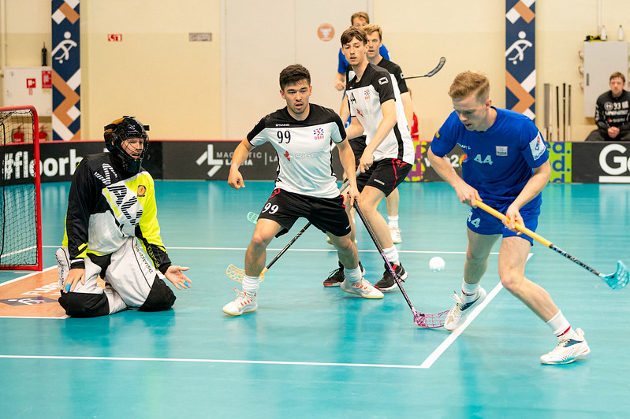
We thought that the IFF’s idea to shorten Floorball’s game time on an international level was already dead and buried after strong resistance few years ago. Little did we know. It seems to be a sort of perpetual motion machine – an idea with very questionable reasoning behind it but still going strong.
Finnish floorball website’s (paakallo.fi) editor Joel Siltanen wrote a thorough piece last weekend about IFF’s plans to reduce floorball match’s game time from 3 x 20 minutes to 25% shorter, 3 x 15 minutes. As the process haven’t been very public, this came as a big surprise for floorball community in Finland – after a short round of enquiries, perhaps even bigger surprise in Sweden. Yes, there have been talks about testing 3 x 15 minutes during World Championship Qualifications and in World Games but at least in Finland, this haven’t been treated very seriously. Well, perhaps it should have been as it seems that there has been a very strong push towards 3 x 15 minutes in IFF’s cabinets.
It is more than possible that when IFF has their General Assembly during men’s WFC in Switzerland in November, IFF’s Central Board will propose a change in game format (from 3 x 20 min to 3 x 15 min). General Assembly will have a vote and as every member association has one equal vote, the quite eager lobbying campaign for shorter games seems to have worked – as of today, Future of Floorball is very likely to be 3 x 15 minutes.
The Origins of Shorter Game Format
The first time 3 x 15 minutes format (with 2+12 as maximum squad size) was played more seriously was in World Games 2017 in Wroclaw.
Excerpt from IFF’s own Event Evaluation (WG2017 in Wroclaw)
“3.4. Learnings
Despite many doubtful comments before the event, the reduction of playing time and the number of players in the team roster was very successful. After the event the IFF received very good feedback from the teams about the team size and many suggested that this could be a possibility for some future IFF events as well. The Floorball media was, generally, positive to the format and playing the 5v5 proved to be a better choice than playing 4v4, which was the other option which was considered. Some were perhaps surprised that it had worked so well. The major surprise from a sporting perspective was that the quality of the sport was extremely high. The fact that, with a reduced playing time, only the best of the best played, made the standard of the games excel to a new level.
The other main concern was what the physical condition of the teams would be in end of July, which is the middle of the pre-season period for the players. Despite these concerns, it was generally discussed among the national team’s coaches and media, that this was the most exciting international event ever played and the quality of the matches were on absolute top performance level, especially in the final between Sweden and Switzerland.”
The vagueness of the praise is tangible: “many suggested that…”, “some were perhaps surprised that..”, and finally “it was generally discussed among the national team’s coaches and media, that this was the most exciting international event ever played”. There are no documents, official enquiries or qualitative research to support these claims.
This premise has been acting like an anchor of sorts for the IFF. After this vague and subjective evaluation, it seems that 3 x 15 minutes has been more or less IFF’s aim for Floorball’s international format.
There have been, of course, some formal questionnaires about Future of Floorball aimed for IFF’s Ordinary Members. But, as Complex Floorball -blog wrote already in 2018:
“This (the lack of floorball competence) can be seen in the questionnaire form sent to the member states, which is not only completely lacking thoroughness, but also in its very guiding manner to find out the opinion of the member states. Complex Floorball writer Perttu Kytöhonka compared the questionnaire to a situation, where a person is asked whether he would like to be punched in the stomach or in the face.. The member states are not left with a lot of space to move regarding this. Another interesting aspect is regarding who has been responsible for this questionnaire, as it still seems a bit unclear. Does the IFF know what it’s board members are doing?”
IFF seems to have chosen the end result beforehand – that Floorball should be played in 3 x 15 minutes format – and has later tried to find reasoning to support that idea.
Dubunking the Main Claims
IFF had central board meeting in March in which they discussed the outcome of the Future of Floorball SWOT from the IFF Association Meeting. The CB discussed the different aspects of the Strengths, Weaknesses, Opportunities and Threats of the Future of Floorball proposal. Their SWOT bullet points and comments below.
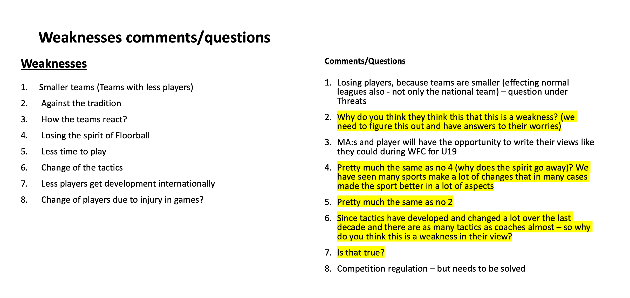
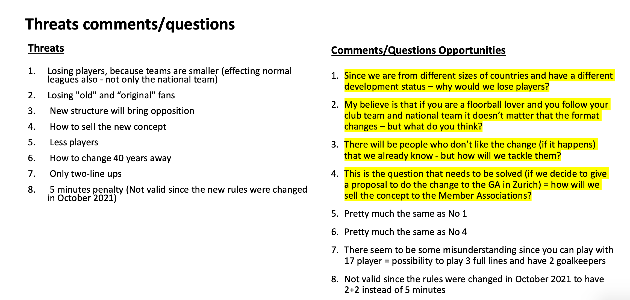

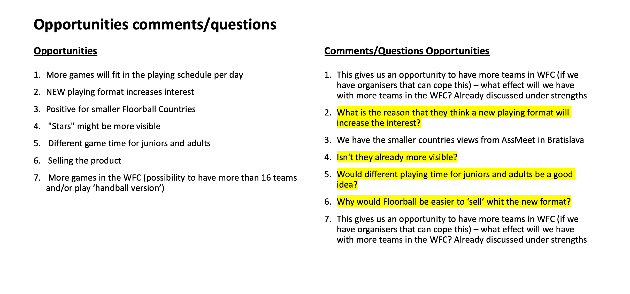
I try to comment further on some of the claims. I have picked three main points and combined them with similar claims.
1. “Closing the Gap from 1-4 (ranking) to 5-12 is one of the main reasons for doing the change – more even matches
The claim that by reducing the game time by 25% from 3 x 20 minutes to 3 x 15 minutes, the gap between the TOP4 and teams ranked from 5 to 12 would somehow close down is seriously flawed. Reducing the game time has nothing to do with closing the gap of quality between nations. Reducing the game time will not create more licensed players to member nations, it doesn’t create new coaches, it doesn’t make the facilities better and in the end, it doesn’t make floorball to have more meaning to more people.
It has the possible consequence to affect the results of the games by making the results more unpredictable. With reduced game time, the underdog has an increased possibility to achieve a positive result against superior team. That is however totally different thing – do we want the best team to win or do we want more unpredictable results? Sports in general should be about finding the best team, not the luckiest. In the end, it is also very very likely, that the best teams with the biggest resources are able to adjust to new rules faster and thus, make the gap even wider.
The best case in this scenario is that the IFF creates an artificial look of developing competition. However, it has nothing to do with real development.
2. “Our product will be so much more fun to look at on higher level, active playing, more spectators”
By reducing the game time, the value of a goal – and therefore also value of a mistake, a penalty, a single refereeing decision – is proportionally increased. As the coaches try to control the controllables, this will most likely lead to a more conservative and passive approach – not to more fun and attractive game as IFF is suggesting.
3 x 15 minutes format has been tested in World Games in Wroclaw, in World Championship Qualifications and in U19 Women’s WFC (and in forthcoming WG in Birmingham). The games might have well been attractive in Wroclaw but a) the sample size is too small, b) the format was new to all teams and so the game plan and strategies were not fully developed and c) the World Games itself were not approached by TOP4 teams as their main goal. Games with less meaning to the teams can well be entertaining to watch but with higher stakes, the end product is very likely to be something else that was hoped. It also remains a mystery how exactly were the games “more fun to look at”? Higher xG in both ends? More challenges per minute? Longer running distance per player? What?
Floorball is an invasion sport and as such, a complex phenomena. It is very difficult to create “a more fun game to look at” – whatever that means to each individual. IFF’s hypothesis that shorter games end up creating better entertainment doesn’t hold water. Shorter games mean that every decision, mistake, penalty and goal counts more. That rarely leads to more entertaining end product and again – whatever that means.
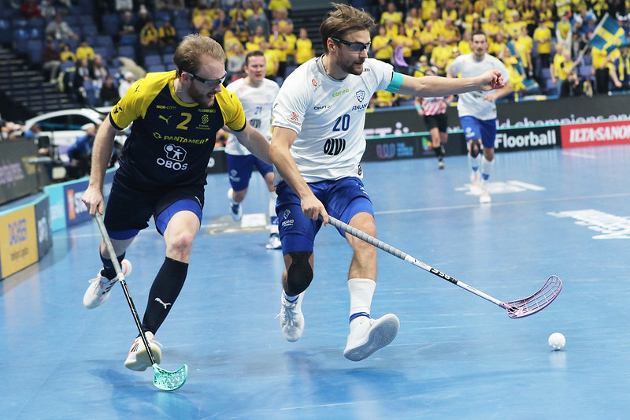
3. “Multisport events – showing that we are willing to adjust to a more modern version (and Olympic opportunity)”
Officially the IFF’s unrealistic Olympic dream is no more the main target (it was mentioned however in IFF Central Board’s swot analysis) but multisport events such as World Games are seen as a very important part of making the sport bigger. One can say that multisport events seem to be so important for IFF that the game itself becomes secondary.
Even though the World Championships are by far the most important tournament for national teams, I can see the why multisport events are seen as a good opportunity for the sport. It is also understandable that the length of the games and especially sizes of a full floorball squad are very difficult to fit to already packed multisport events. There is however an easy solution for that – create an olympic version (or multisports version) of the game. There are examples already – for example Kleinfeld-version played in Switzerland (3v3 + goalies in a smaller rink). Finnish Federation is also experimenting with different versions of the game.
That is of course, a totally different thing. Huge global sports such as Rugby and Basketball have their own smaller versions played in olympics – 7v7 rugby and 3v3 basketball. Volleyball and handball have their beach versions. Those sports however have not changed their core – there are still the normal versions. Sometimes they make rule changes if the game itself is somehow in need of adjustments. Floorball has one good example of this when the return pass to the goalie was prohibited. There are surely still things to experiment – the game is never finished product – but the reasons behind the rule changes should rise from the game itself.
First, Do No Harm
Floorball at its core is a game of skill and speed. Recently there has been a lot of discussion about refereeing in big games and that it now seems that hockey has stricter rules – or implementation of the written rules – for example for holding and body contacts. The speed of play has gone up and there has already been too many incidents where a contact has led to a dangerous brain injury (concussion) or close calls. Why not try to make floorball more fun to look at by actually following the rules? For me it sounds like something worth a try.
In the end, my biggest concern and disappointment comes from the fact that IFF’s process has been everything but open and transparent. The poor questionnaires, one example from U19 WFC – both in quality and in quantity (only 23 answered (10 team members, 7 referees, 3 IFF members, 1 from organisers, 1 volunteer and 1 media representative) don’t do favours towards IFF’s credibility and trust that it knows what it is doing. It doesn’t feel that the process is professionally guided and handled with respect towards all the thousands of people – players, coaches, professionals, volunteers – who are working to make the game better.
Have the best players and coaches been heard? Have their opinions even been asked? Have there been communication with professionals within floorball, what are their thoughts and concerns? If so, where’s the documentation?
It seems that the IFF, who we trust should have the sport’s best interest in mind have forgot their most important task – the game and the people who love the game.
